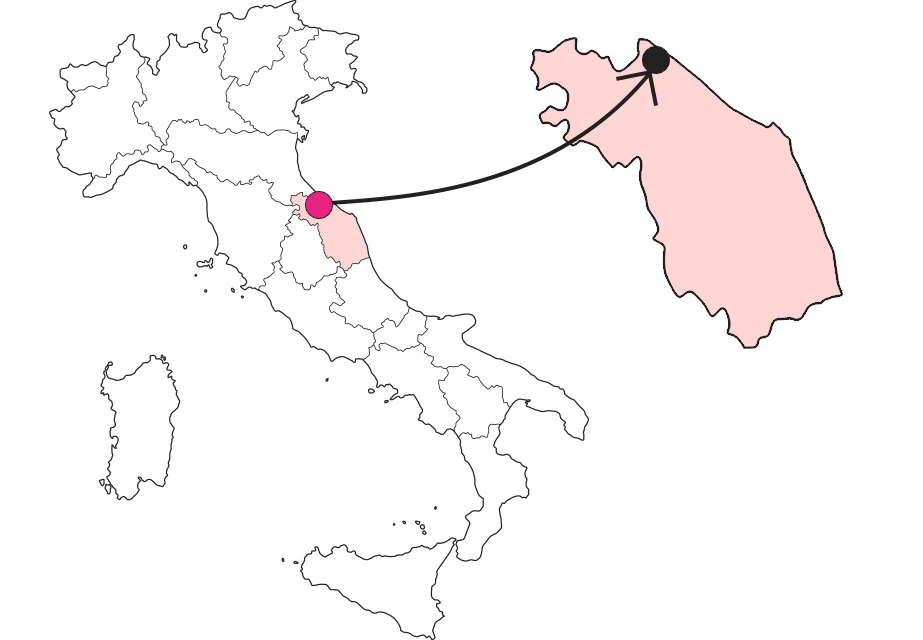SHARRYLAND


Divine Reverberations at Sanzio Theater
Stone sphinxes, crimson interiors, and ornamental reliefs: emotions past and present



Where is

What it is and where it is
The Raffaello Sanzio Theater with three tiers of boxes and gallery, capable of seating 460, is a neoclassical red brick building with a facade punctuated by six brick half-columns and adorned with two stone sphinxes. It faces Corso Garibaldi at the end of the arcade that connects it to Republic Square. Singular is its location above the fifteenth-century tower of the Mercatale: this location, desired with the consent of all from its first design, involved the closure of the Ramp by Francesco di Giorgio Martini, significantly altering with its bulk the view of the Torricini. The purpose was to have the entertainment venue in the center of the city.
Why it is special
Before the Sanzio Theater was built, the nobles and the bourgeoisie found entertainment and spectacle in the small Theater of the Academy of Nobles Pascolini, built in 1637 on the ground floor of the former Ducal Palace, along the right side of the courtyard of honor; it was active until 1879 and demolished in 1881. This was Urbino's first permanent theater, cramped and uncomfortable, capable of only 240 seats even after the 1723 expansion. Thus the new Sanzio Theater is an expression of the collective desire for culture and the need for entertainment, designed especially to accommodate opera in music, which in the 19th century required more space due to changing technical and logistical needs.
Not to be missed
The theater is also a place and monument of art: the decorations of the interior cover almost all surfaces, and create in the whole a warm chromatic synthesis, which in the Sanzio Theater varies from the crimson of the seats, curtain and boxes, to the pink of the parapets of the boxes, to the gilding of the ornamental reliefs, suggesting an atmosphere of other times. In the modern atrium are busts of two greats of the Urbino Renaissance: Raphael, by Carlo Finelli (1853), and Bramante by Giambattista Pericoli. In the hall, The Muses, painted in the vault, are the work of Raffaello Antonioli, a young painter from Gubbio; later are the four pilasters on the proscenium, in Art Nouveau style, executed by Diomede Catalucci.
A bit of history
The building was a major urban intervention of the 19th century. It called on the pragmatic Vincenzo Ghinelli, who built the theater from 1847 to 1853, and also designed the portico, the exedra in front of the theater to allow carriages to maneuver, and the landscaping of the pincio escarpment. The opening of the theater took place on August 20, 1853, with Rigoletto and Il trovatore and two ballets. Theater activity stopped after World War II, and the limelight was turned off for 34 years, until November 15, 1982, when it was reopened after restoration by Giancarlo De Carlo.
Trivia
Great artists and singers not infrequently tread the boards at the Sanzio. The Urbino aristocrats, who came together in the Società del Teatro as early as 1845, wanted opera in music at all costs and personally committed themselves and sometimes went into debt in order to have the most celebrated vedettes of the time. Pietro Mascagni conducted the orchestra in 1899; debutante Renata Tebaldi sang an aria by Catalani in 1943. A recent discovery was the presence, from July 2 to 16, 1876, of
Enter the Map of Italy's Undiscovered Wonders and find treasures where you least expect it... Inspire, Recommend, Share...
The Map thanks:
Enter the Map of Italy's Undiscovered Wonders and find treasures where you least expect it... Inspire, Recommend, Share...
Where is


